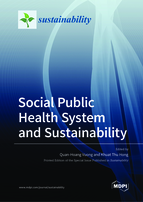Social Public Health System and Sustainability
A special issue of Sustainability (ISSN 2071-1050). This special issue belongs to the section "Health, Well-Being and Sustainability".
Deadline for manuscript submissions: closed (31 December 2020) | Viewed by 137467
Special Issue Editors
Interests: emerging capital markets; data management; scientific data; applied statistics (frequentist and Bayesian); emerging market economics; financial database systems; sustainable financial management; entrepreneurial finance
Special Issues, Collections and Topics in MDPI journals
Special Issue Information
Dear Colleagues,
The social public health systems (SPHS) in both the developed and developing worlds have profound impacts on social sustainability. Both the notions of social public health system and sustainability have expanded substantially over time due to rising complexities of societies, global mobility of workforce, increasing globalization and regionalization of economies and socio-economic forces, to name just a few. Nonetheless, as a research topic, the nexus and inter-relationships between the two critically important notions of today's science appear to have been underresearched.
In the intersection of the two, the following areas of research have emerged to be of critical importance for the scientific enterprise:
- Gender issues, reproductive health, environmental and occupation health
- Increasing mobility, migration workers and social vunerability in relation to social health and sustainability matters
- Emerging socio-cultural and economic values in SPHS and sustainability concerns
- The role of healthcare and health services managent and social sustainability
- Impacts of Social networks and technologies on social health
- Education in SPHS and sustainability
- Institutions building, regulatory frameworks and political agenda in coping with rising complexity in SPHS and sustainability problems
- Socio-economic inequality and the future of SPHS
- Information, databases and science policy in improving the knowledge base about SPHS and sustainability
- Evidence-based policymaking in SPHS and sustainability
This Special Issue invites your academic contributions, i.e., research articles, review articles, essays, perspectives, to help enhance our understanding of the above-mentioned missing nexus, from different angles of analysis, and also to improve the future agenda on addressing issues that hamper SPHS and sustainability.
Dr. Quan-Hoang Vuong
Dr. Khuat Thu Hong
Guest Editors
Manuscript Submission Information
Manuscripts should be submitted online at www.mdpi.com by registering and logging in to this website. Once you are registered, click here to go to the submission form. Manuscripts can be submitted until the deadline. All submissions that pass pre-check are peer-reviewed. Accepted papers will be published continuously in the journal (as soon as accepted) and will be listed together on the special issue website. Research articles, review articles as well as short communications are invited. For planned papers, a title and short abstract (about 100 words) can be sent to the Editorial Office for announcement on this website.
Submitted manuscripts should not have been published previously, nor be under consideration for publication elsewhere (except conference proceedings papers). All manuscripts are thoroughly refereed through a single-blind peer-review process. A guide for authors and other relevant information for submission of manuscripts is available on the Instructions for Authors page. Sustainability is an international peer-reviewed open access semimonthly journal published by MDPI.
Please visit the Instructions for Authors page before submitting a manuscript. The Article Processing Charge (APC) for publication in this open access journal is 2400 CHF (Swiss Francs). Submitted papers should be well formatted and use good English. Authors may use MDPI's English editing service prior to publication or during author revisions.
Keywords
- social health
- preventive medicine
- social sustainability
- information systems and databases
- science policy in social health, political agenda
- complexities and uncertainties
- evidence-based policy making







